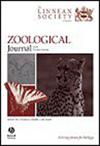Molecular phylogeny of Trictenotomidae (Coleoptera: Tenebrionoidea): insights into species validation and biogeography of genus Autocrates
IF 3
2区 生物学
Q1 ZOOLOGY
引用次数: 0
Abstract
Trictenotomidae, one of the most charismatic and enigmatic groups of beetles, known for their large size and distinctive mandibles, is widely distributed throughout tropical and subtropical Asia. New species are continually being discovered, and the known range of the group has been expanded considerably by the discovery of Autocrates maqueti Drumont in the Korean Peninsula, ~2,000 km from its previously known distribution in the Chinese mainland highlands. A comprehensively sampled multigene phylogenetic tree of Trictenotomidae, including all six species of Autocrates and five species of Trictenotoma, was reconstructed using multigene data. Using the resulting phylogeny, we performed divergence time estimation, biogeographical assessments, and molecular species delimitation. All six known species of the genus Autocrates were found to be valid in all four molecular species delimitation scenarios, indicating the need for further taxonomic research on these poorly understood taxa. The A. maqueti population in South Korea forms a genetically distinct clade in all genetic analyses, suggesting that it is a natural distribution rather than a result of anthropogenically driven spread. The Korean A. maqueti population is likely to have been isolated since ~1.8 Mya, when the Yellow Sea was still a landmass, highlighting the need for targeted conservation measures in South Korea.Trictenotomidae (Coleoptera: Tenebrionoidea) 的分子系统学:对 Autocrates 属物种验证和生物地理学的启示
甲虫(Trictenotomidae)是最具魅力和最神秘的甲虫类群之一,以其巨大的体型和独特的下颚而闻名,广泛分布于亚洲热带和亚热带地区。新物种不断被发现,在朝鲜半岛发现的 Autocrates maqueti Drumont 大大扩展了该类群的已知分布范围,距离之前已知的中国大陆高原分布区约 2000 公里。利用多基因数据重建了一个全面取样的Trictenotomidae多基因系统发生树,包括所有6种Autocrates和5种Trictenotoma。利用所得到的系统发生树,我们进行了分化时间估计、生物地理评估和分子物种划分。我们发现,Autocrates 属的所有六个已知物种在所有四种分子物种定界方案中都是有效的,这表明有必要对这些了解甚少的类群进行进一步的分类研究。韩国的 A. maqueti 种群在所有遗传分析中都形成了一个遗传上独特的支系,这表明该种群是自然分布的,而非人为传播的结果。韩国的 A. maqueti 种群很可能在大约 180 万年前就已经与世隔绝了,当时黄海还是一片陆地,这凸显了在韩国采取有针对性的保护措施的必要性。
本文章由计算机程序翻译,如有差异,请以英文原文为准。
求助全文
约1分钟内获得全文
求助全文
来源期刊
CiteScore
6.50
自引率
10.70%
发文量
116
审稿时长
6-12 weeks
期刊介绍:
The Zoological Journal of the Linnean Society publishes papers on systematic and evolutionary zoology and comparative, functional and other studies where relevant to these areas. Studies of extinct as well as living animals are included. Reviews are also published; these may be invited by the Editorial Board, but uninvited reviews may also be considered. The Zoological Journal also has a wide circulation amongst zoologists and although narrowly specialized papers are not excluded, potential authors should bear that readership in mind.

 求助内容:
求助内容: 应助结果提醒方式:
应助结果提醒方式:


